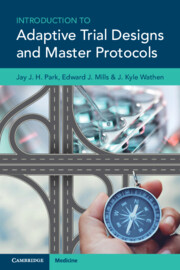Book contents
- Introduction to Adaptive Trial Designs and Master Protocols
- Introduction to Adaptive Trial Designs and Master Protocols
- Copyright page
- Content
- Preface
- About the Authors
- Part I Introduction and History of Clinical Trial Research
- Part II Basic Ingredients for Adaptive Trial Designs and Common Types
- Part III Basic Ingredients for Master Protocols
- Chapter 6 Characteristics and Principles of Master Protocols
- Chapter 7 Platform Trials
- Chapter 8 Basket Trials and Umbrella Trials
- Part IV Case Studies of Adaptive Trial Designs and Master Protocols
- Part V A Practical Guide to Adaptive Trial Designs and Master Protocols
- Index
- References
Chapter 8 - Basket Trials and Umbrella Trials
from Part III - Basic Ingredients for Master Protocols
Published online by Cambridge University Press: 20 March 2023
- Introduction to Adaptive Trial Designs and Master Protocols
- Introduction to Adaptive Trial Designs and Master Protocols
- Copyright page
- Content
- Preface
- About the Authors
- Part I Introduction and History of Clinical Trial Research
- Part II Basic Ingredients for Adaptive Trial Designs and Common Types
- Part III Basic Ingredients for Master Protocols
- Chapter 6 Characteristics and Principles of Master Protocols
- Chapter 7 Platform Trials
- Chapter 8 Basket Trials and Umbrella Trials
- Part IV Case Studies of Adaptive Trial Designs and Master Protocols
- Part V A Practical Guide to Adaptive Trial Designs and Master Protocols
- Index
- References
Summary
This chapter discusses characteristics of basket and umbrella trials and their key design considerations. Basket trials refer to clinical trials conducted to test one or more targeted therapies on multiple diseases that share common molecular alternations or other predictive risk factors. Umbrella trials refer to clinical trials that test two or more targeted therapies for a single disease that is stratified into multiple groups. In addition to sample size and randomisation considerations that are important to all clinical trials, specific design considerations that are important for basket and umbrella trials include: biological plausibility of targeted intervention(s), accuracy of biomarker assays, biospecimen collection procedures, and prevalence of targeted biomarker.
- Type
- Chapter
- Information
- Introduction to Adaptive Trial Designs and Master Protocols , pp. 87 - 100Publisher: Cambridge University PressPrint publication year: 2023



